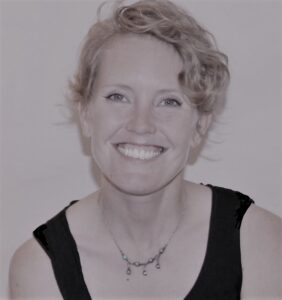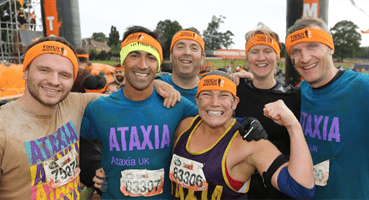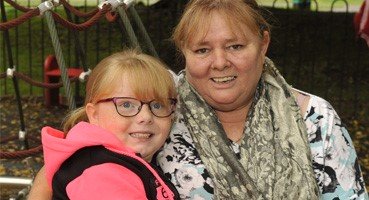 Recently, our research intern Scarlett Parr-Reid sat down with Lucie Hogger, Speech and Language Therapist at the London Ataxia Centre to talk about the speech and language therapy services offered at the centre, and the research taking place into this aspect of ataxias.
Recently, our research intern Scarlett Parr-Reid sat down with Lucie Hogger, Speech and Language Therapist at the London Ataxia Centre to talk about the speech and language therapy services offered at the centre, and the research taking place into this aspect of ataxias. Lucie Hogger has worked in adult speech and language therapy since 2008 in hospital, rehabilitation and community settings. She recently completed her PhD on the medicines practices of people with dementia and their carers, and works clinically in the ataxia service and the facial rehabilitation service at the National Hospital for Neurology and Neurosurgery, UCLH, London. She is passionate about supporting people with communication difficulties to flourish in their conversations and social relationships.
What does your day-to-day role look like at the London Ataxia Centre, and how long have you been working there?
I’ve been working with the London ataxia centre since the beginning of August 2023. They secured some extra funding after the COVID-19 pandemic, meaning that the post is now being made permanent, which is great. I work within outpatient neurology alongside three other speech therapists who also have expertise in ataxia.
One service we offer is the weekly multidisciplinary clinic, which is a therapy-led clinic. The main function of the MDT clinic is to provide a thorough assessment and to identify people’s needs. From there, from a speech therapy point of view, some people will come through to our online group therapy. Group speech therapy sessions are for people with who have a mild-to-moderate ataxic dysarthria (speech difficulty), and they run online over five weeks for one hour per week. There’s usually three or four people per group in addition to me.
The function of the group is to teach voice and speech exercises, aiming to change underlying issues with your speech. For example, I see lots of people run out of breath when speaking, so we teach exercises to improve breath support and control for speaking. I refer to the exercises as being weightlifting exercises for your speech, as they improve the strength behind the voice. For some people, the rate of their speech is the same as it’s always been, but because their articulation is a little bit off or imprecise, they don’t have enough time to get their articulators – their tongue and their lips – to be in the right place at the right time. So, we work on slowing their speech rate with the effect of improving intelligibility.
And there’s an educational component to the group. We talk about how normal speech works. The group members identify which part of their speech system they think they’re having problems with, or having the most problems with, which is nice as often it’s the first time that people have heard speech talked about in that way or broken down.
There’s lots of opportunities for social participation within the group. As a tertiary centre, we have people from all over the UK attending. We’ve had nice outcomes both on a speech level and with confidence and social participation.
Why have you taken a group-based approach to speech therapy, and what kind of benefits have come from seeing people in groups?
Often, we find people who come to the group that haven’t had any speech therapy before may have lost confidence in communicating with unfamiliar people. They may say “I don’t want to be mistaken for being drunk” or “It feels really embarrassing when people ask me to repeat myself”. Some people will avoid small interactions in shops or on the phone with strangers. You can imagine there’s a downward negative cycle where if you do it less frequently, you feel less confident about it. So, the group offers an opportunity to talk with strangers in a safe environment.
In addition to the group sessions, there’s daily practise at home in between, and part of that will be around using strategies for clear speech with people who are unfamiliar.
For example, one gentleman in the group, his goal was to ask for a coffee in a restaurant instead of getting his wife to do it. I can come up with suggestions for how to approach the communication situation, but often it’s the other group members that help, which is a way of validating other people’s strategies and coming up with things that I would never have thought of because I’m not living that reality. We can talk beforehand about things like having a script to say, ‘I have ataxia, and this is how it affects my speech’. Or it might be about centring and grounding yourself before you go into that communication situation. This might mean taking a deep breath or rehearsing what you want to say before you say it.
One of the real benefits of peer-led and peer-developed strategies is the opportunity to practise in a group and give and receive feedback on each other’s speech. That helps to tune into things which you might not have thought of before, like pitch and voice quality and rate of speech. You’re both tuning into your own speech and tuning into other people’s.
Do you collect feedback on what people think of the sessions?
We collect pre- and post-outcome measures. So, we do a sentence intelligibility test. We measure maximum phonation time (how long you can hold a sound such as ‘ahh’), and collect objective measures, and then we take some psychosocial and subjective measures.
I do the initial outcome session before the group and then a speech language therapy assistant Dan does the outcome session, so people give feedback in that session. And then Dan repeats the outcome measures.
We’ve done 16 or 17 group cohorts now since the speech and language course started in 2022. The group therapy is based in part on the work of Prof Anja Lowit at the University of Strathclyde. They trialled an online intervention with nine participants which consisted of four individual sessions over 2 weeks followed by 20 patient-led group sessions over 4 weeks. They found the intervention significantly reduced vocal strain, improved reading intelligibility and increased participation in communication situations and confidence in speaking.
There was a paper I saw recently from a team in the Netherlands at Radboud UMC. The paper was published a couple months ago using a biofeedback app for voice training. One of the things that’s quite difficult is to judge and monitor your own loudness and pitch. The app allows you to set the parameters that you want for your own voice and speech, and then when you do your exercises on the app, it will give you a green if you’re within these parameters or red if you’re outside of them. Patients tended to speak slower after the intervention, used more pauses, and in general were satisfied using the Voice trainer app during the therapy. Read the paper here.
What are some of your goals within speech and therapy services?
There’s going to be three of us now working across the ataxia service. So, it’ll be me and two other speech therapists called Tabitha and Danielle.
One of the things that we’re really interested in doing, which I think was tried a little bit before is having peer facilitators in the group. This may be people who’ve been through the group before and who would be interested in coming back to support other group members. I can see all sorts of positives, although there are quite a lot of logistical things to think about in how you support someone to do that.
Using an app to support biofeedback between group sessions is something I’ve given quite a lot of thought to. I’m keen to explore how we can support people to best set up their habits during that five-week period.
A key focus is how the group is meeting everybody’s needs and ensuring that we’re not inadvertently excluding anyone. There are people who are excluded on the basis that their dysarthria is too severe for them to take part in the group. Those people may be seen locally by local speech therapists. So it may be that people with more severe dysarthria don’t have access to the same group peer support. I’d encourage them to contact Ataxia UK if they’d like to be in contact with other people with ataxia.
What advice do you have for people who are interested in accessing speech therapy?
Firstly, I would say even if your speech is only a minor thing for you now, don’t feel that it’s not valid for input. Don’t feel that there’ll be more deserving people. It’s heartbreaking when I hear that from people. Please don’t feel that the severity of your speech needs to be an indicator for accessing services.
If you’re not already registered with local speech therapy, ask your GP for a referral or self-refer if you can. All adult speech therapists work with people with neurological disorders, so any speech therapist will be able to help you. Because it’s a rare disease, it may be that the local speech therapist doesn’t know many people with ataxia, but lots of speech therapists will also see some people with ataxic dysarthria after a stroke or a brain injury. So, if you’re not part of a highly specialist service like ours or Sheffield, not to be disheartened by that.
If their speech therapist feels like they’d like some support with what they’re doing, they can contact the team, and I would always be happy help. That can come from the person with ataxia as well.
You can read interviews from the other members of the London Ataxia Centre multidisciplinary team here.






